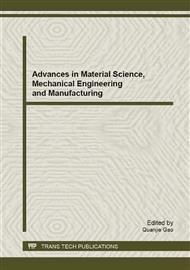[1]
J.C. Chang, B.S. Kim, N.H. Heo, Stress Relief Cracking on the Weld of T/P 23 Steel, Procedia Engineering, Vol. 10, (2011), pp.734-739.
DOI: 10.1016/j.proeng.2011.04.122
Google Scholar
[2]
P.K. Liaw, G.V. Rao, M.G. Burke, Creep fracture behaviour of 214Cr-1Mo welds from a 31-year-old fossil power plant, Materials Science and Engineering, vol. A131, (1991), pp.187-201.
DOI: 10.1016/0921-5093(91)90395-4
Google Scholar
[3]
Y. Chuman. M. Yamauchi. and T. Hiroe, Study of evolution procedure of multi-axial creep strength of low alloy steel, Vol. 171-174. (2000), pp.305-312.
DOI: 10.4028/www.scientific.net/kem.171-174.305
Google Scholar
[4]
D. Longdale and P.E.J., Flewitt The effect of hydrostatic pressure on the uniaxial creep life of a 214%Cr1%Mo steel, Proc. R. Soc. Lond, Vol. A 373, (1981), pp.491-509.
DOI: 10.1098/rspa.1981.0006
Google Scholar
[5]
Q. Xu, Development of constitutive equations for creep damage behavior under multi-axial states of stress. Advances in Mechanical Behavior, Plasticity and Damage, (2000), pp.1375-1382.
Google Scholar
[6]
Q. Xu, M. Wright And Q.H. Xu, The development and validation of multi-axial creep damage constitutive equations for P91. ICAC 11: The 17th international conference on automation and computing. Huddersfield, UK. September 10. (2011).
Google Scholar
[7]
Q.H. Xu, Q. Xu, Y.X. Pang, and M. Short, Current state of developing creep damage constitutive equation for 0. 5Cr0. 5Mo0. 25V ferritic steel, the 2nd International Conference on Machinery, Materials Science and Engineering Applications (MMSE 2012) 16th-17th, June 2012. Wuhan, China.
DOI: 10.4028/www.scientific.net/amr.510.812
Google Scholar
[8]
Q.H. Xu, Q. Xu., Z. Lu, Y.X. Pang, and M. Short , A Review of Creep Deformation and Rupture Mechanisms of Low Cr-Mo Alloy for the Development of Creep Damage Constitutive Equations under Lower Stress, the 10th International Conference on Scientific Computing, 22th-25th, July, 2013, Las Vegas, USA. ( has been accepted on 21/4/2013).
Google Scholar
[9]
M. Fujimoto. M. Sakane. S. Date and H. Yoshia (2005), Multi-axial creep rupture and damage evalution for 2. 25Cr-1Mo Froged Steel, Soc. Mat. Sci., Vol. 54. pp.149-154. (In Japanese).
Google Scholar
[10]
Evaluation of Filler Materials for Transition Weld Joints between Grade 91 to Grade 22 Components. EPRI, Palo Alto, CA: 2005. 1009758.
Google Scholar
[11]
J.D. Parker and A.W.J. Parsons, High temperature deformation and fracture processes in 2. 25Cr1Mo-0. 5Cr0. 5Mo0. 25V weldments, International Journals of Pressure Vessels and Piping, Vol. 63, (1995), pp.45-54.
DOI: 10.1016/0308-0161(94)00047-m
Google Scholar
[12]
N. G. Needham, Cavitation and Fracture in Creep Resisting Steels: Final Report. Commission of the European Communities. (1983).
Google Scholar
[13]
J. Dobrzański, Internal damage processes in low alloy chromium–molybdenum steels during high-temperature creep service, Journal of Materials Processing Technology, Vol. 157–158. (2004), pp.297-303.
DOI: 10.1016/j.jmatprotec.2004.09.047
Google Scholar
[14]
J. Dobrzański, A. Zieliński, M. Sroka, Microstructure properties investigations and methodology of the state evaluation of T23 (2. 25Cr-0. 3Mo-1. 6W-V-Nb) steel in boilers application, Vol. 32, (2009), pp.142-153.
Google Scholar
[15]
Nuclear Research Nuclear Research Index, Section A, Structural Integrity, http: /www. hse. gov. uk/nuclear/nri-topics/2012/section-a. pdf. (2010), (Accessed on 25/3/2012).
Google Scholar
[16]
B. Dyson., Use of CDM in materials modeling and component creep life prediction, American Society of Mechanical Engineers, Vol. 122(3, ) (2000), pp.281-296.
DOI: 10.1115/1.556185
Google Scholar
[17]
P. Mohyla and V. Foldyna, Improvement of reliability and creep resistance in advanced low-alloy steels, Materials Science and Engineering: A, 510–511. (15), (2009), pp.234-237.
DOI: 10.1016/j.msea.2008.05.056
Google Scholar
[18]
J.D. Parker, Creep behaviour of low alloy steel weldments, International Journals of Pressure Vessels and Piping, 63. (1995), pp.55-62.
DOI: 10.1016/0308-0161(94)00051-j
Google Scholar
[19]
J.D. Parker and A.W. Parsons, The tempering performance of low-alloy steel weldments. International Journals of Pressure Vessels and Piping, Vol. 57, (1994), pp.345-352.
DOI: 10.1016/0308-0161(94)90040-x
Google Scholar
[20]
F. Kawashima, T. IGRI, T. Tokiyoshi, A. Shiibashi and N. Tada Micro-macro combined simulation of the damage progress in low-alloy steel welds subject to Type IV creep failure, Vol. 47, (2004), pp.410-418.
DOI: 10.1299/jsmea.47.410
Google Scholar
[21]
B.J. Cane Interrelationship between creep deformation and creep rupture in 214Cr-1Mo steel, Metal Science, (1979), pp.287-294.
DOI: 10.1179/03063453.1979.11674139
Google Scholar
[22]
R.N. Hore and Ghosh., Computer simulation of the high temperature creep behaviour of Cr–Mo steels, Materials Science and Engineering, Vol. A. 528(19–20), (2011), pp.6095-6102.
DOI: 10.1016/j.msea.2011.04.050
Google Scholar
[23]
R. L. Klueh, Interation solid solution hardening in 2. 25Cr-1Mo steel, Materials Science and Engineering, Vol. 35, 1978, pp.239-253.
DOI: 10.1016/0025-5416(78)90126-x
Google Scholar
[24]
C.A. Hippsley., Precipitation sequences in heat-affected zone of 2. 25Cr-1Mo steel during stress-relief heat treatment, Metal Science, (1981), pp.137-147.
DOI: 10.1179/030634581790426705
Google Scholar
[25]
C. S. Kim, Ik-Keun Park, Kyung-Young Jhang, Nonlinear ultrasonic characterization of thermal degradation in ferritic 2. 25Cr-1Mo steel, NDT and International, Vol. 42, (2009), pp.204-209.
DOI: 10.1016/j.ndteint.2008.09.002
Google Scholar
[26]
K. Fujiyama, T. Iseki, A. Komatsu and N. Okabe , Creep life assessment of 2. 25Cr-1Mo piping steel and of its simulated HAZ material, Material Science Research International, vol. 4, (1997), pp.237-243.
DOI: 10.2472/jsms.46.12appendix_237
Google Scholar


